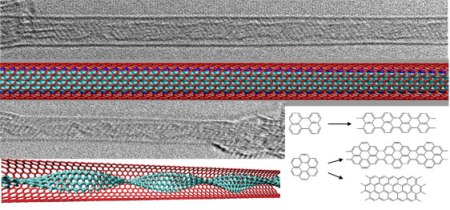Researchers at Umeå University and Aalto University have discovered an efficient method to fabricate graphene nanoribbons directly within single-walled carbon nanotubes.
In the method, the scientists have utilized carbon nanotubes’ inner hollow space as a single-dimensional chemical reactor to fabricate encapsulated graphene. An exciting characteristic of this space is that the occurrence of chemical reactions is different from that under bulk three-dimensional environment.
 High resolution TEM images of graphene nanoribbons encapsulated in SWNTs
High resolution TEM images of graphene nanoribbons encapsulated in SWNTs
The researchers have utilized perylene and coronene, which are huge organic molecules, as building blocks for the production of narrow and long graphene nanoribbons within the carbon nanotubes. The researchers’ earlier study found that coronene molecules can react with one another at specific conditions to create dimers, trimers and lengthier molecules in a form of bulk powder.
The finding recommended the utilization of coronene molecules in the production of graphene but they have to be aligned in one plane for the needed reaction. Single-walled carbon nanotubes’ inner space is an ideal area to push molecules into the edge-to-edge geometry needed for the polymerization reaction.
In the latest study, the scientists have demonstrated the possibility of the reaction. When they analyzed the first samples under electron microscopy, they found that all carbon nanotubes’ inner spaces were packed with graphene nanoribbons. The experiments’ success also depended mainly on the selection of nanotubes. Soon, the scientists discovered that encapsulated graphene nanoribbons’ shapes can be altered by utilizing various types of aromatic hydrocarbons.
As nanoribbons’ properties vary with their width and shape, the new method paves way for novel applications. Alexandr Talyzin, one of the researchers, stated that in the future, hybrids can be produced by coupling nanotubes and graphene in all probable combinations. The novel hybrid fabrication method is easily scalable, very simple and enables 100% packing of nanoribbons inside carbon nanotubes.